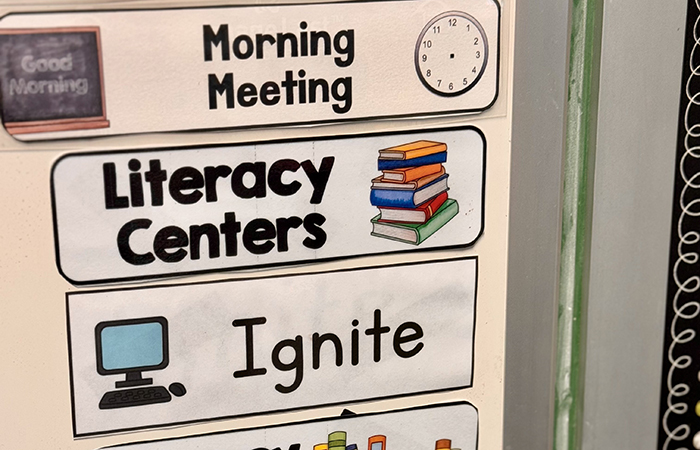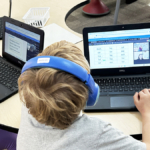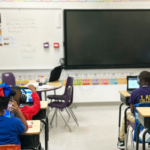There’s a mountain of evidence that shows providing tutoring for students who need academic support is one way schools can close equity gaps and accelerate student progress.
Simply adding tutoring in schools isn’t enough, however. How you implement your district or school tutoring program can make all the difference for student outcomes, and that’s especially true when it comes to partnering with a tutoring organization to close students’ foundational reading skills gaps.
Are you wondering what tutoring looks like in the schools where students are achieving the most reading growth? Looking for a roadmap to ensure your tutoring partnership will impact student success?
To help you craft a tutoring partnership that puts student success at the center, we’ve developed this step-by-step guide to implementing tutoring in your school.
Find out how to get teachers on board with this intervention option and when the best time is for tutoring sessions, plus get tips on how to measure the efficacy of your tutoring program to ensure students are getting what they need most to reach educational goals.
Implementing Successful Tutoring for Students
1. Opt for a High-Dosage Tutoring Model
The number of schools offering tutoring for students has taken off in recent years — four in five public schools now offer at least one type of tutoring to students. The types on offer vary with some districts mandating teachers set aside a certain number of hours for tutoring to peer-to-peer options that enlist high-performing students as tutors.
The most effective method is high-dosage or high-impact tutoring — researchers have found the model gives students an average of more than four months of additional learning in elementary literacy.
To qualify as “high-dosage tutoring,” your program should be:
- Offered at school, ideally during the school day
- Delivered at least 3 times per week; ideally 5 days
- Aligned to the school’s evidence-based Tier 1 curriculum
- Taught with high-quality instructional materials
- Built on a low student-to-tutor ration; ideally one-to-one
- Led by qualified professional tutors
- Driven by diagnostic and progress monitoring data
- Able to provide sustained and strong relationships between tutors and students
2. Make Room in the School Day for Tutoring Sessions
For decades, tutoring has largely been relegated to after-school programs. This has served to exacerbate educational inequalities as many families who lack transportation options or have other obligations during the after-school hours are unable to take advantage of these programs.
What’s more, researchers have found after-school tutoring programs across the nation show limited uptake as they compete against other after-school activities, and parents may worry about adding more time onto an already lengthy school day.
By making room in your school day for your students’ tutoring sessions, you eliminate those barriers, providing more equitable access for students from all socioeconomic backgrounds.
If you’re worried about losing instructional time, keep in mind that these sessions can take place during center time, during a specific intervention block where kids may rotate between different interventions, or some other time during the day that doesn’t interfere with Tier 1 instruction in core content areas.
The data bears out the benefits of making time in the school day for tutoring for your students too. Success rates for tutoring during the school day is nearly double the rates of after-school tutoring programs.
3. Schedule Student Tutoring Sessions Every Day
“During the school day” isn’t the only scheduling consideration that will help you maximize the impact of tutoring for students.
Research has consistently found kids need consistency in tutoring, with daily sessions proving the gold standard for improving student outcomes.
And yet, when University of Southern California researchers looked at schools that reported they offer high-impact tutoring, they found that the tutoring dosage being offered to most students was simply not enough to qualify as “high impact” as just 25 percent of students were scheduled to meet with their tutors at least three times per week.
Similarly, when researchers at the National Center for Analysis of Longitudinal Data in Education Research examined tutoring programs at 12 districts in 10 states, they found the districts that had planned to offer students 30 to 60 hours of tutoring per year actually provided just 12 to 14 hours of the service.
Blocking out short periods of intervention time every day of the week and ensuring that time is consistently scheduled will enable your students to progress more quickly in their skills. Consistent dosage leads to better outcomes and also enables kids to foster relationships that contribute to SEL, which can be a powerful motivator when kids are persisting through challenging content.
4. Bring School Staff Along on the Journey
Are you wondering what your school staff will think of adding high-impact tutoring for students? The time to talk about it is now.
Teacher buy-in is crucial to the success of tutoring in schools, and the majority of American teachers support the concept.
When researchers at Stanford University surveyed teachers to learn their perspectives on high-impact tutoring, they found the news was overwhelmingly positive. Teachers told the researchers they consider it one of their best ways to address student learning loss. Just 2 percent of teachers in the survey said that they do not support embedding tutoring into the school day at all.
Not surprisingly, the primary reason teachers say they support high-dosage tutoring is the simple fact that it will help their students.
As one teacher told Stanford’s researchers:
“Students would benefit by having the one-to-one experience and learning at their pace to clarify instructions or provide more prompts to get them thinking about the topic. It would provide another way of accessing the curriculum.”
With 25 individual students in a classroom — all with different learning needs – one teacher does not have the bandwidth to differentiate reading instruction for all 25. That’s where tutoring comes in, and it’s one of the many reasons teachers are quick to proclaim the benefits.
Talking to your teaching staff early on ensures they’re partners in the process, rather than onlookers, and it allows them to provide their own valuable insights into their students’ needs.
Teachers can identify which students will best be served by high-impact tutoring, prepare their students for the program, and encourage positive behaviors that will ensure student success.
Once the program is launched, teachers are among those who can best leverage data from your tutoring partner as well, reinforcing the skills kids need with extra practice.
The more involved teachers are allowed to be, the more they can support their students.
5. Share Important Student Information With Your Tutoring Partner
Thanks to the structure of high-dosage tutoring, tutors are able to provide individualized instruction to every student — something that can be next to impossible for a single classroom teacher with a room full of 25 to 30 students.
To help tutors truly tailor instruction, however, your partner needs to be armed with a complete picture of the student’s needs and how they best access information. This includes historical data on learning styles, insights into accommodations in a students’ IEP, or the native language spoken by a multilingual learner.
You may be wary of sharing students’ personally identifiable information (PII), but your tutoring partner should have a process in place to keep PII safe. Don’t be afraid to ask for your partner’s policy on protecting students’ information.
6. Prioritize Tutoring Session Attendance
There’s a clear line between student attendance in the classroom and student success, and the same can be said for attendance in tutoring sessions. Spotty attendance results in learning loss and requires tutors to revisit the same material over and over again.
Fortunately, you have a little extra help here. High-impact tutoring has been found to boost student attendance by as much as 7 percent. Because students enjoy their sessions so much, it motivates them to attend school.
You can keep this momentum going with a few simple things:
- Block out students’ regular tutoring sessions, and try not to schedule other school events at the same time. This ensures students involved in tutoring don’t feel punished because they have to miss out on the fun assembly to attend tutoring.
- Ensure the district IT department has been looped into the process, so they can quickly address technology issues that would present students from attending their tutoring sessions.
- Keep parents and guardians informed about students’ progress in the program to fuel their investment and leverage their partnership to ensure students don’t miss a session.
- Remind students about upcoming tutoring sessions with verbal reminders, texts sent home to caregivers, and a spot on visual schedules in the classroom.

7. Use Your Tutoring Data Wisely
Effective tutoring programs use data to assess their own effectiveness at improving student learning and make needed adjustments to instruction. Your tutoring partner should be able to provide your district or school with all of that data, so use it wisely!
You can make the most of the numbers you receive by:
- Using a data-driven approach to select which students should be selected for the program and to determine when students who have reached educational goals can “graduate” from in-school tutoring.
- Keeping teachers in the data loop, so they can reinforce students’ learning in the classroom.
- Sharing data with parents and guardians. This way they know what skills their child is working on and what’s next, and it will help drive their investment in the program.
8. Create a Waiting List for Tutoring Services
As your students work one-to-one with their tutors to master their skills, they’ll reach goals — such as mastering foundational reading skills — that will set them up for academic success.
That means they’ll be able to graduate from the tutoring program and open a seat for other students to get that same targeted intervention!
About Ignite Reading
Ignite Reading delivers 1:1 online tutoring to students who need extra support in learning to read. Our expert tutors teach students the foundational skills they need to become confident, fluent readers by the end of 1st grade.
With a team of literacy specialists and highly trained tutors, we provide daily, targeted instruction that quickly closes decoding gaps, so students can successfully make the transition from learning to read to reading to learn.




